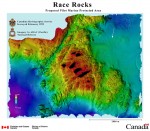Three boatloads of Guests departed the Pearson College docks for Race Rocks Ecological Reserve at 8:30 on the morning of April 7, 1999. For many of the workshop visitors, this was their first visit to Race Rocks, and the weather cooperated. On their return, they toured the Race Rocks reference Collection recently set up in the library of Lester Pearson College.The sign for the collection represents the name given to the area by the people who speak the Clalum language. It was pointed out as : Race Rocks ![]() “Qhuwyingh” Pilot Marine Protected Area. This name in Clalum means the area of swift waters. After coffee break in the faculty lounge, the first session was held in Max Bell Hall on the campus.
“Qhuwyingh” Pilot Marine Protected Area. This name in Clalum means the area of swift waters. After coffee break in the faculty lounge, the first session was held in Max Bell Hall on the campus.
In opening the session in Max Bell Hall, special recognition was given to Dr. Bristol Foster who was in attendance. It was noted that he was “The Grandfather “of the ecological reserve at Race Rocks as he had been so helpful when he served as the Director of Ecological Reserves in the BC Parks Department in 1979-80. Pearson College students worked with his office to expedite the creation of the reserve.

In this view, the black area is either where land is located, or it represents the margins of the survey. Bentinck Island appears at the top of the picture. Great Race Rocks, where the light station is located is the large island in the center of the picture. Shoreline margins are not yet accurate. The present boundaries of the Ecological reserve are more or less the outer limits of the red area at 36 meters.
Jim Galloway of the Institute of Ocean Sciences in Sidney, B.C. gave a presentation on “Managed Surveys” done recently at Race Rocks. The images from the multibeam sonar have provided a unique look at the hydrography down to 100 meters. The outline of his presentation is in the database.
John Harper of Coastal and Ocean Resources, Inc. gave his presentation on the Seabed Imaging and Mapping System – Seabed Classification of Substrate, Epifauna and Epiflora. This system uses a towed video camera to acquire seabed imagery that is geo-referenced.
Jon Preston of Quester Tangent Corp. gave a presentation on the recently completed computer generated imagery from the Race Rocks sonar data.
In the last session of the morning, Scott Wallace, who has been studying MPA’s in his Doctorate program at UBC’s program of Management and Conservation, gave a slide show on his work with abalone in research done two years ago at Race Rocks. He noted that the population age class distribution as determined by measurement of size at Race Rocks indicated a good level of recruitment.
The importance of marine refugia and no-take zones for recovery of stocks was emphasized. Scott pointed out that there are no old-growth areas left in the ocean. Whatever our efforts, they are really for restoration. His slide of the Ling Cod taken in an artificial reef community devoid of a complex community of organisms contrasted with the one taken at Race Rocks, surrounded by a luxurious community
In the afternoon Garry Fletcher presented the Race Rocks Ecological Overview Database. Recognition was given to Norm Healey who assisted in the programming of certain aspects of the database. The database consists of over 260 records of ecologically related information on the Race Rocks Area. In addition five other databases are linked.
- The Conservation Data Centre Southern Vancouver Island records.
- The Metchosin Environmental Inventory
- The Race Rocks herbarium
- The Photo/slide Database
- The Race Rocks Temperature- Salinity Database.
A brief survey of the structure of the database and a demonstration of the search capabilities showing the searchable categories, and keyword search functions was carried out. During the presentation, three other participants were asked to comment on their work at Race Rocks, which is referenced in the Race Rocks Database. Dr. Anita Brinckmann- Voss commented on her work on taxonomy of hydroids, and research on patterns of seasonal change as demonstrated in her most recent publication. Donna Gibbs of the Vancouver Aquarium commented on her experiences in diving and doing a species list which is also connected through the database. Giovanni Rosso, a Pearson College student, gave a brief summary of his findings on polymorphism in the intertidal Littorina snails at Race Rocks.
